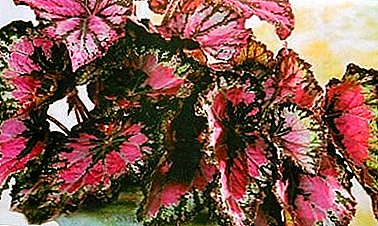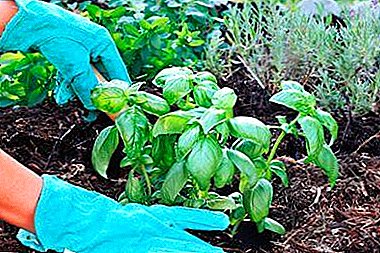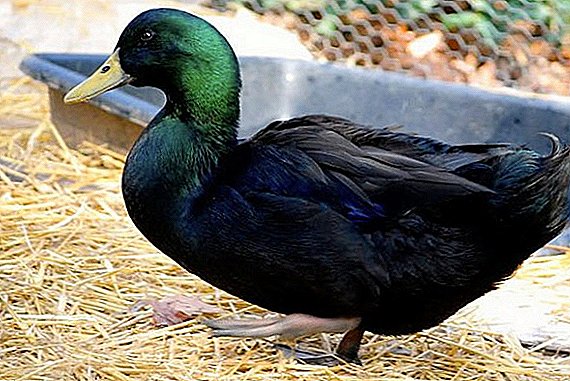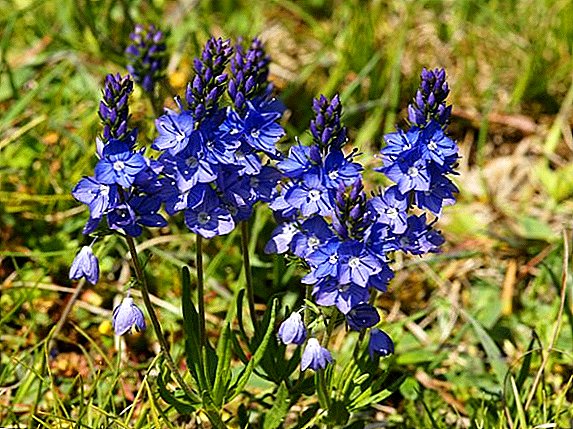
Royal Begonia - A hybrid species of the Begonia family. This is a perennial herb that originates from the northeastern state of India called Assam.
Its other names are royal rex begonia, "Napoleon's ear", and "elephant's ears."
Description of the royal begonia
Root system represented powerful creeping rhizome.
The stem is fleshy, small in size, covered with reddish bristles.
Leaves large, asymmetrical, pointed, have oblong petioles and a jagged edge. Sheet plates have a bright and varied colors, has green, scarlet, crimson, purple, purple and even silver inclusions. Veins on the leaves may be a different color.
- Interestingly, the particular decoration of this plant is caused by certain physical needs:
- The bright color and roughness of the leaves increase the surface temperature of the leaf plates, helping them to evaporate more moisture. This process contributes to the production of nutrients by the roots and, consequently, the intensive development of rhizomes.
- The asymmetry of the leaves allows the plant to evenly drink enough sunshine. Different forms of leaves allow them not to block each other the flow of sunlight.
The flowers are pink and inconspicuous with a diameter of up to 1 centimeter. Against the background of bright leaves do not carry decorative value. Seeds ripen in small fruits.

Home care for royal Begonia
Begonia does not require special conditions of detention but in order to preserve bright colors, it is necessary to create certain conditions.
Landing
The first planting of the plant after successful cultivation from the seed is made on the fourth week. When planting should follow the recommendations on the composition of the soil and type of pot.
Priming
For rex begonias, nutrient soils with medium acidity are preferred. In specialized stores you can buy ready-made soil for begonias. For self-preparation of the soil will need to mix the following components: peat - 1 part, sand - part, leaf earth - 2 parts, humus - 2 parts.
Pot selection
To capacity for planting royal begonias there are some requirements. The pot should be wide for the characteristic development of the root system, contain drainage holes and a tray. The height of the pot is not critical, as the roots do not go far.
Watering

Watering should be moderate and regular. Earthen ball should not be overdried, the soil needs a slightly moist condition.
But excessive moisture contributes to the deterioration of fleshy stems and roots, so the stagnation of water in the pot should not be allowed.
When watering is recommended to avoid moisture on the leaves, which can lead to leaf rot.
Watering is carried out with filtered or distilled water at room temperature.
Light mode
Royal Begonias require good lighting with diffused sunlight. Direct sunlight is undesirable for leaves. Window sills are suitable with a reference point to the east or west.
Pruning
From the beginning of the flowering period, it is recommended to cut the flower stalks, as they lead to depletion of the plant and deterioration of the appearance of the leaves.
At the end of winter - the beginning of spring is approaching a period of active growth, to be prepared by pinching the rhizome and reorienting the young parts of the root to the center of the pot. Thanks to the actions done, the growth of new shoots on the thinned rhizome and the formation of lush bushiness are resumed.
It is advisable to graft an old plant to restore an attractive appearance.
Thermal mode
The optimum temperature for good development of the royal begonia ranges from 17 to 25 degrees Celsius.

Begonia grows well all year round, slightly slowing down the development during the onset of cold weather. In this regard, the creation of a rest period with a reduced temperature is not required.
Breeding
For reproduction of the royal begonia, leaf cuttings, rhizomes and seeds are used.
For leaf breeding, the stalk is divided into several parts of the same length. Pieces of cuttings are placed in a wet peat ground. Sprouts are planted at an oblique angle in order to successfully rooting.
Perhaps the cultivation of begonias Rex from seed. But it should be borne in mind that this method does not always bring a good result, since seed germination has a low percentage.
Lifespan
Begonia life span varies depending on the conditions in which it is located. Average, plants live 2-3 years. But they are perfectly amenable to grafting and continue to live in a new plant.
Fertilizer and dressing
In the warm season, the flower needs constant feeding with the use of mineral complex fertilizer. Top-dressings should be done 3 times a month, stimulating active growth.
Organic fertilizers are very useful for begonias. Well-fermented for two weeks manure, which is applied in liquid form when diluted with water.
During the spring period, the fertilizer should consist of nitrogen, potassium and phosphorus in a ratio of 1: 1: 1, and by the beginning of cold weather the content of potassium and nitrogen is reduced by 2 times.
Transfer
Royal Begonia follows replant in spring, because during this period, it is more resistant to root fractures and can recover quickly.
The pot for transplantation is chosen with a wider diameter than the previous one. Capacity should not be deep, as the root of the plant grows closer to the soil surface and does not go far.
In the process of transplanting rhizome can be carefully freed from the old substrate.
You can not deepen the neck of the rhizome, otherwise the plant will rot.
Features of winter care
The winter period for this type of begonia is characterized by a slowdown in development. Special care is not required. Watering moderate.
Diseases and measures to prevent them

Diseases of the royal begonias develop as a result of violations of the conditions of care.
- Diseases and their causes:
- Root rot caused by excess moisture in the soil;
- Leaf thinning due to insufficient light;
- Brown spots as a result of sunburn;
- Powdery mildew on leaf sheets due to high humidity;
- Drying the edge of the sheet caused by lack of moisture.
All these ailments happen through the fault of the florist. Therefore, it is not difficult to eliminate them by resuming the correct care of begonia.
Pests and methods of dealing with them
Begonia can be affected by scutes, thrips and spider mites.
For prevention, you should conduct regular inspections of leaves for the presence of pests.
In advanced cases, treatment with special medicines will be required.
Royal Begonia perfectly fit into any interior. Due to the colorful color of the leaves, it will become a rich living decoration in the house.
A photo
Then you can see home care photos of the royal Begonia rex:
















